International Journal of Nursing Studies, Vol 77, Pages - 232-242
VerifiedAdded on 2022/08/17
|8
|2242
|9
AI Summary
A systematic review of heart failure dyadic self-care interventions focusing on intervention components, contexts, and outcomes. International journal of nursing studies, 77, 232-242. In the above article, the authors throw light on the importance of self-care intervention that will help in improving the conditions of patients suffering from heart failure. The report also shows how, when a self-care intervention is followed alone without any help from the carers results in adverse consequences such as death.
Contribute Materials
Your contribution can guide someone’s learning journey. Share your
documents today.
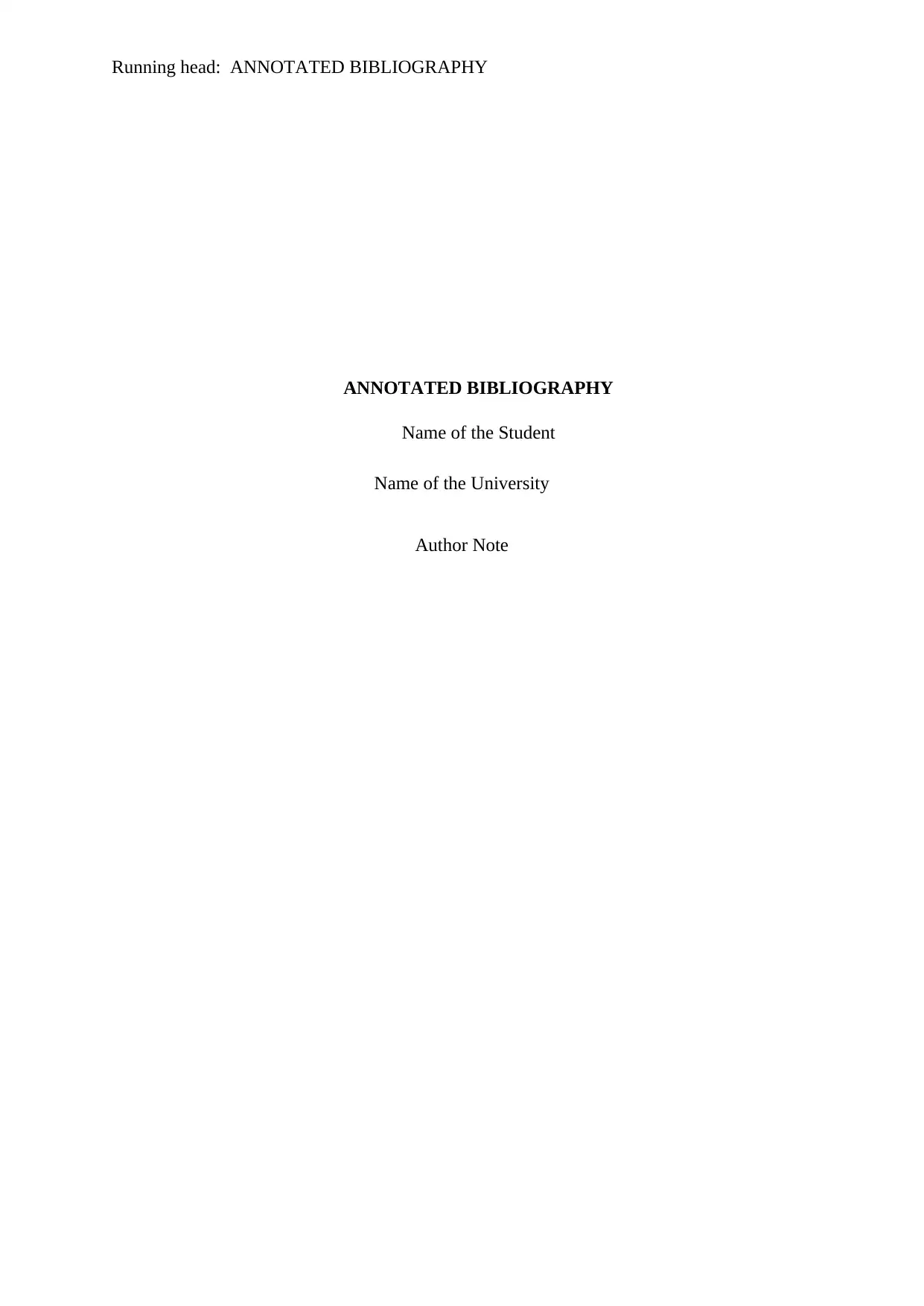
Running head: ANNOTATED BIBLIOGRAPHY
ANNOTATED BIBLIOGRAPHY
Name of the Student
Name of the University
Author Note
ANNOTATED BIBLIOGRAPHY
Name of the Student
Name of the University
Author Note
Secure Best Marks with AI Grader
Need help grading? Try our AI Grader for instant feedback on your assignments.
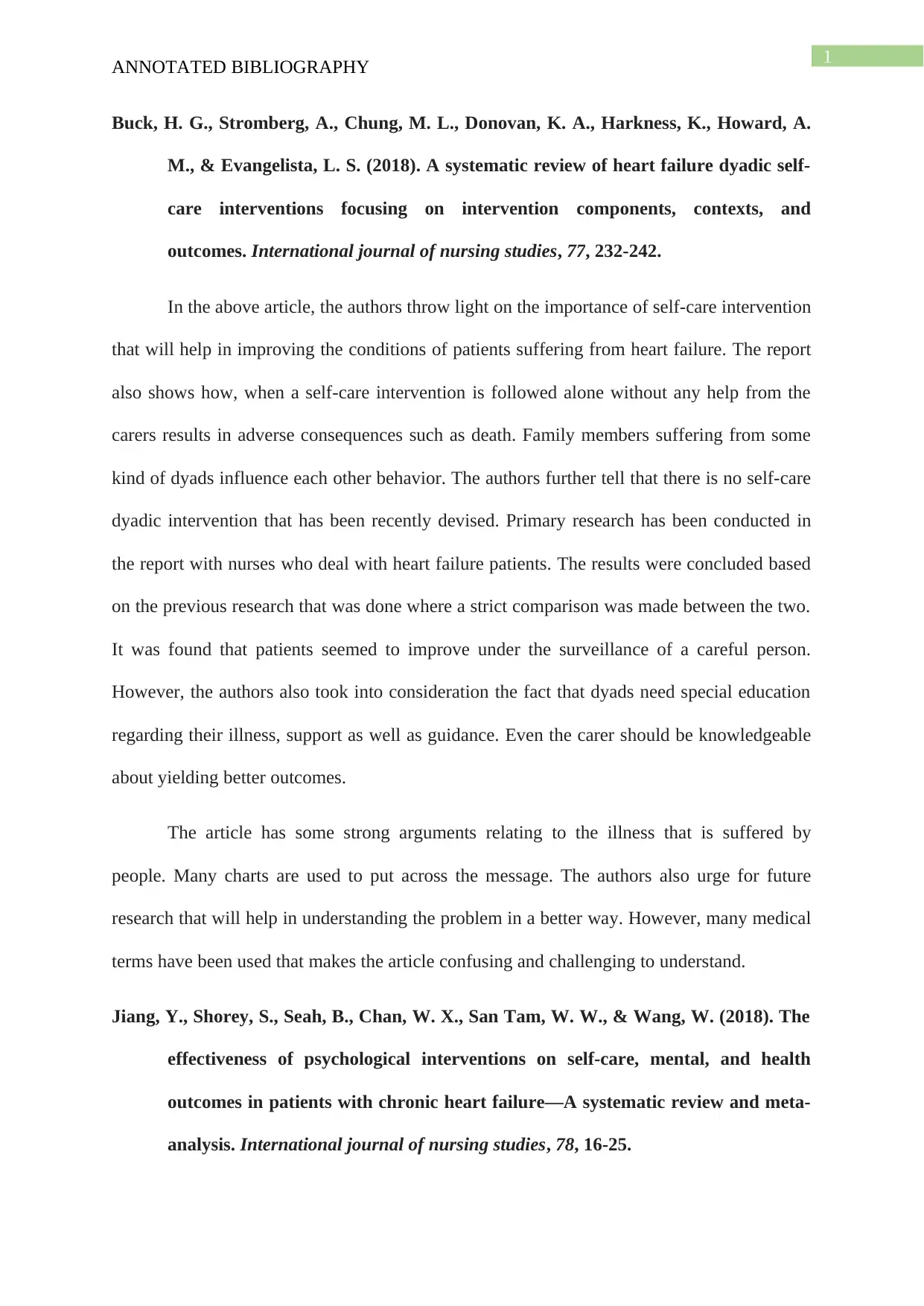
1
ANNOTATED BIBLIOGRAPHY
Buck, H. G., Stromberg, A., Chung, M. L., Donovan, K. A., Harkness, K., Howard, A.
M., & Evangelista, L. S. (2018). A systematic review of heart failure dyadic self-
care interventions focusing on intervention components, contexts, and
outcomes. International journal of nursing studies, 77, 232-242.
In the above article, the authors throw light on the importance of self-care intervention
that will help in improving the conditions of patients suffering from heart failure. The report
also shows how, when a self-care intervention is followed alone without any help from the
carers results in adverse consequences such as death. Family members suffering from some
kind of dyads influence each other behavior. The authors further tell that there is no self-care
dyadic intervention that has been recently devised. Primary research has been conducted in
the report with nurses who deal with heart failure patients. The results were concluded based
on the previous research that was done where a strict comparison was made between the two.
It was found that patients seemed to improve under the surveillance of a careful person.
However, the authors also took into consideration the fact that dyads need special education
regarding their illness, support as well as guidance. Even the carer should be knowledgeable
about yielding better outcomes.
The article has some strong arguments relating to the illness that is suffered by
people. Many charts are used to put across the message. The authors also urge for future
research that will help in understanding the problem in a better way. However, many medical
terms have been used that makes the article confusing and challenging to understand.
Jiang, Y., Shorey, S., Seah, B., Chan, W. X., San Tam, W. W., & Wang, W. (2018). The
effectiveness of psychological interventions on self-care, mental, and health
outcomes in patients with chronic heart failure—A systematic review and meta-
analysis. International journal of nursing studies, 78, 16-25.
ANNOTATED BIBLIOGRAPHY
Buck, H. G., Stromberg, A., Chung, M. L., Donovan, K. A., Harkness, K., Howard, A.
M., & Evangelista, L. S. (2018). A systematic review of heart failure dyadic self-
care interventions focusing on intervention components, contexts, and
outcomes. International journal of nursing studies, 77, 232-242.
In the above article, the authors throw light on the importance of self-care intervention
that will help in improving the conditions of patients suffering from heart failure. The report
also shows how, when a self-care intervention is followed alone without any help from the
carers results in adverse consequences such as death. Family members suffering from some
kind of dyads influence each other behavior. The authors further tell that there is no self-care
dyadic intervention that has been recently devised. Primary research has been conducted in
the report with nurses who deal with heart failure patients. The results were concluded based
on the previous research that was done where a strict comparison was made between the two.
It was found that patients seemed to improve under the surveillance of a careful person.
However, the authors also took into consideration the fact that dyads need special education
regarding their illness, support as well as guidance. Even the carer should be knowledgeable
about yielding better outcomes.
The article has some strong arguments relating to the illness that is suffered by
people. Many charts are used to put across the message. The authors also urge for future
research that will help in understanding the problem in a better way. However, many medical
terms have been used that makes the article confusing and challenging to understand.
Jiang, Y., Shorey, S., Seah, B., Chan, W. X., San Tam, W. W., & Wang, W. (2018). The
effectiveness of psychological interventions on self-care, mental, and health
outcomes in patients with chronic heart failure—A systematic review and meta-
analysis. International journal of nursing studies, 78, 16-25.
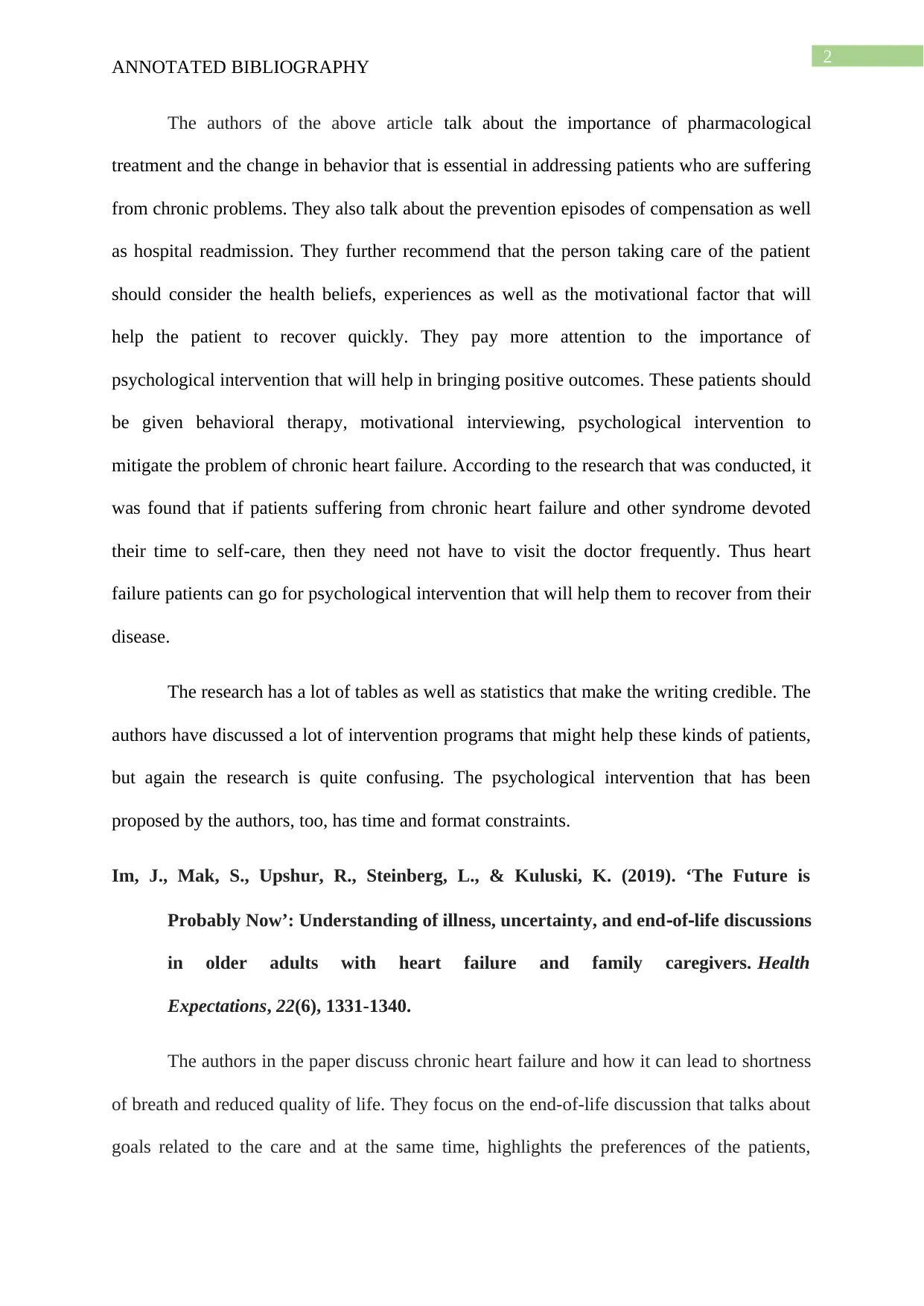
2
ANNOTATED BIBLIOGRAPHY
The authors of the above article talk about the importance of pharmacological
treatment and the change in behavior that is essential in addressing patients who are suffering
from chronic problems. They also talk about the prevention episodes of compensation as well
as hospital readmission. They further recommend that the person taking care of the patient
should consider the health beliefs, experiences as well as the motivational factor that will
help the patient to recover quickly. They pay more attention to the importance of
psychological intervention that will help in bringing positive outcomes. These patients should
be given behavioral therapy, motivational interviewing, psychological intervention to
mitigate the problem of chronic heart failure. According to the research that was conducted, it
was found that if patients suffering from chronic heart failure and other syndrome devoted
their time to self-care, then they need not have to visit the doctor frequently. Thus heart
failure patients can go for psychological intervention that will help them to recover from their
disease.
The research has a lot of tables as well as statistics that make the writing credible. The
authors have discussed a lot of intervention programs that might help these kinds of patients,
but again the research is quite confusing. The psychological intervention that has been
proposed by the authors, too, has time and format constraints.
Im, J., Mak, S., Upshur, R., Steinberg, L., & Kuluski, K. (2019). ‘The Future is
Probably Now’: Understanding of illness, uncertainty, and end‐of‐life discussions
in older adults with heart failure and family caregivers. Health
Expectations, 22(6), 1331-1340.
The authors in the paper discuss chronic heart failure and how it can lead to shortness
of breath and reduced quality of life. They focus on the end-of-life discussion that talks about
goals related to the care and at the same time, highlights the preferences of the patients,
ANNOTATED BIBLIOGRAPHY
The authors of the above article talk about the importance of pharmacological
treatment and the change in behavior that is essential in addressing patients who are suffering
from chronic problems. They also talk about the prevention episodes of compensation as well
as hospital readmission. They further recommend that the person taking care of the patient
should consider the health beliefs, experiences as well as the motivational factor that will
help the patient to recover quickly. They pay more attention to the importance of
psychological intervention that will help in bringing positive outcomes. These patients should
be given behavioral therapy, motivational interviewing, psychological intervention to
mitigate the problem of chronic heart failure. According to the research that was conducted, it
was found that if patients suffering from chronic heart failure and other syndrome devoted
their time to self-care, then they need not have to visit the doctor frequently. Thus heart
failure patients can go for psychological intervention that will help them to recover from their
disease.
The research has a lot of tables as well as statistics that make the writing credible. The
authors have discussed a lot of intervention programs that might help these kinds of patients,
but again the research is quite confusing. The psychological intervention that has been
proposed by the authors, too, has time and format constraints.
Im, J., Mak, S., Upshur, R., Steinberg, L., & Kuluski, K. (2019). ‘The Future is
Probably Now’: Understanding of illness, uncertainty, and end‐of‐life discussions
in older adults with heart failure and family caregivers. Health
Expectations, 22(6), 1331-1340.
The authors in the paper discuss chronic heart failure and how it can lead to shortness
of breath and reduced quality of life. They focus on the end-of-life discussion that talks about
goals related to the care and at the same time, highlights the preferences of the patients,
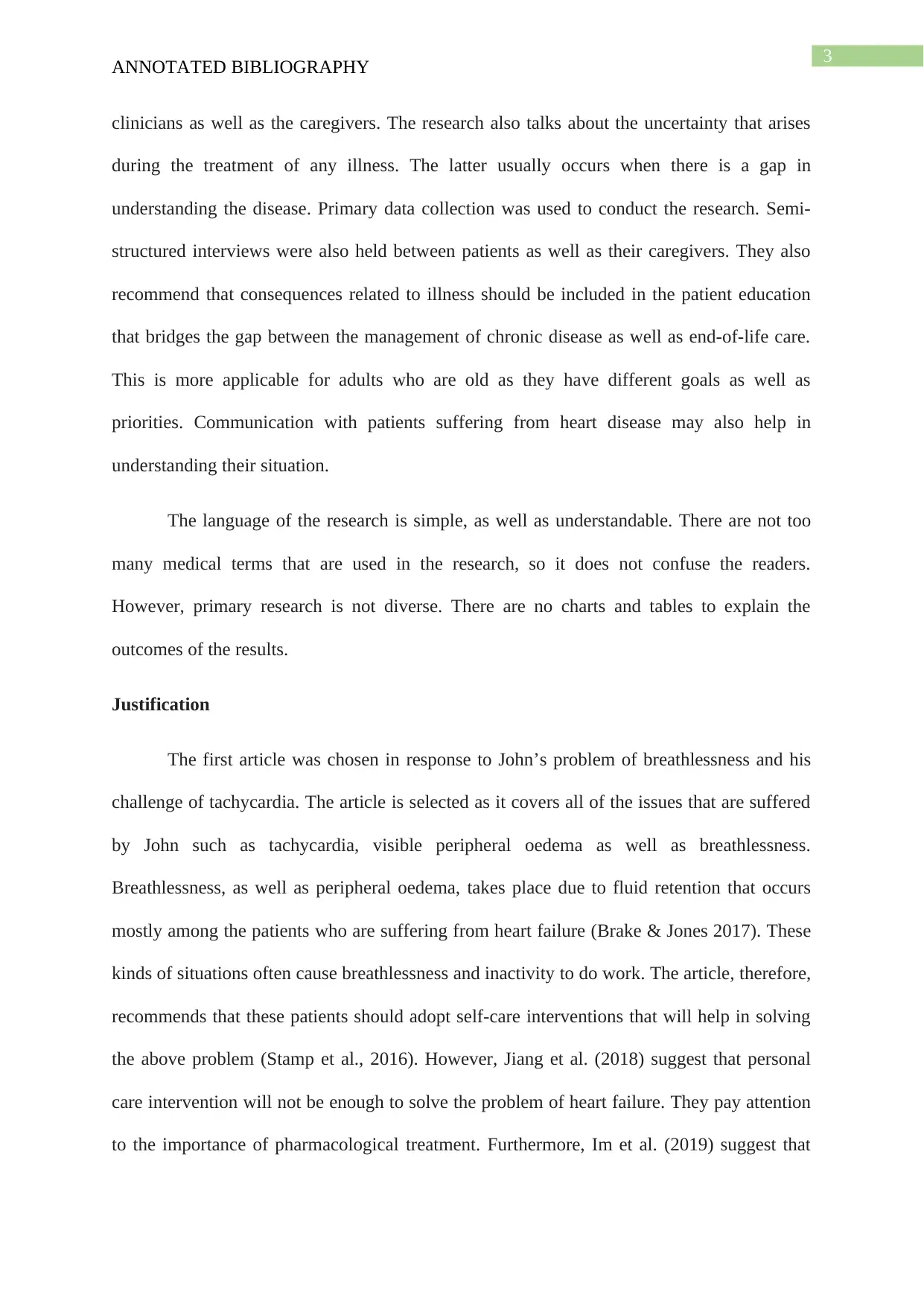
3
ANNOTATED BIBLIOGRAPHY
clinicians as well as the caregivers. The research also talks about the uncertainty that arises
during the treatment of any illness. The latter usually occurs when there is a gap in
understanding the disease. Primary data collection was used to conduct the research. Semi-
structured interviews were also held between patients as well as their caregivers. They also
recommend that consequences related to illness should be included in the patient education
that bridges the gap between the management of chronic disease as well as end-of-life care.
This is more applicable for adults who are old as they have different goals as well as
priorities. Communication with patients suffering from heart disease may also help in
understanding their situation.
The language of the research is simple, as well as understandable. There are not too
many medical terms that are used in the research, so it does not confuse the readers.
However, primary research is not diverse. There are no charts and tables to explain the
outcomes of the results.
Justification
The first article was chosen in response to John’s problem of breathlessness and his
challenge of tachycardia. The article is selected as it covers all of the issues that are suffered
by John such as tachycardia, visible peripheral oedema as well as breathlessness.
Breathlessness, as well as peripheral oedema, takes place due to fluid retention that occurs
mostly among the patients who are suffering from heart failure (Brake & Jones 2017). These
kinds of situations often cause breathlessness and inactivity to do work. The article, therefore,
recommends that these patients should adopt self-care interventions that will help in solving
the above problem (Stamp et al., 2016). However, Jiang et al. (2018) suggest that personal
care intervention will not be enough to solve the problem of heart failure. They pay attention
to the importance of pharmacological treatment. Furthermore, Im et al. (2019) suggest that
ANNOTATED BIBLIOGRAPHY
clinicians as well as the caregivers. The research also talks about the uncertainty that arises
during the treatment of any illness. The latter usually occurs when there is a gap in
understanding the disease. Primary data collection was used to conduct the research. Semi-
structured interviews were also held between patients as well as their caregivers. They also
recommend that consequences related to illness should be included in the patient education
that bridges the gap between the management of chronic disease as well as end-of-life care.
This is more applicable for adults who are old as they have different goals as well as
priorities. Communication with patients suffering from heart disease may also help in
understanding their situation.
The language of the research is simple, as well as understandable. There are not too
many medical terms that are used in the research, so it does not confuse the readers.
However, primary research is not diverse. There are no charts and tables to explain the
outcomes of the results.
Justification
The first article was chosen in response to John’s problem of breathlessness and his
challenge of tachycardia. The article is selected as it covers all of the issues that are suffered
by John such as tachycardia, visible peripheral oedema as well as breathlessness.
Breathlessness, as well as peripheral oedema, takes place due to fluid retention that occurs
mostly among the patients who are suffering from heart failure (Brake & Jones 2017). These
kinds of situations often cause breathlessness and inactivity to do work. The article, therefore,
recommends that these patients should adopt self-care interventions that will help in solving
the above problem (Stamp et al., 2016). However, Jiang et al. (2018) suggest that personal
care intervention will not be enough to solve the problem of heart failure. They pay attention
to the importance of pharmacological treatment. Furthermore, Im et al. (2019) suggest that
Secure Best Marks with AI Grader
Need help grading? Try our AI Grader for instant feedback on your assignments.
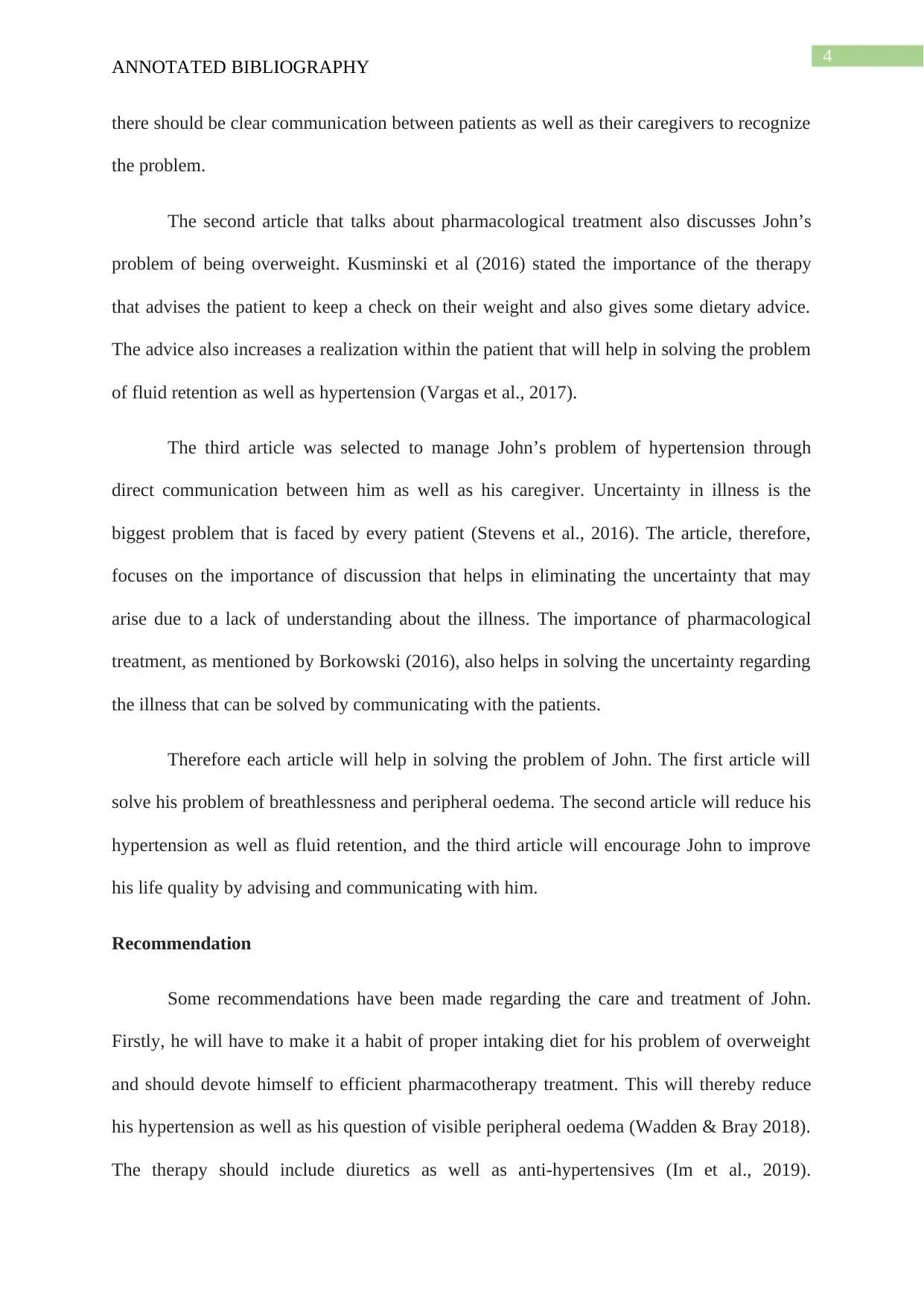
4
ANNOTATED BIBLIOGRAPHY
there should be clear communication between patients as well as their caregivers to recognize
the problem.
The second article that talks about pharmacological treatment also discusses John’s
problem of being overweight. Kusminski et al (2016) stated the importance of the therapy
that advises the patient to keep a check on their weight and also gives some dietary advice.
The advice also increases a realization within the patient that will help in solving the problem
of fluid retention as well as hypertension (Vargas et al., 2017).
The third article was selected to manage John’s problem of hypertension through
direct communication between him as well as his caregiver. Uncertainty in illness is the
biggest problem that is faced by every patient (Stevens et al., 2016). The article, therefore,
focuses on the importance of discussion that helps in eliminating the uncertainty that may
arise due to a lack of understanding about the illness. The importance of pharmacological
treatment, as mentioned by Borkowski (2016), also helps in solving the uncertainty regarding
the illness that can be solved by communicating with the patients.
Therefore each article will help in solving the problem of John. The first article will
solve his problem of breathlessness and peripheral oedema. The second article will reduce his
hypertension as well as fluid retention, and the third article will encourage John to improve
his life quality by advising and communicating with him.
Recommendation
Some recommendations have been made regarding the care and treatment of John.
Firstly, he will have to make it a habit of proper intaking diet for his problem of overweight
and should devote himself to efficient pharmacotherapy treatment. This will thereby reduce
his hypertension as well as his question of visible peripheral oedema (Wadden & Bray 2018).
The therapy should include diuretics as well as anti-hypertensives (Im et al., 2019).
ANNOTATED BIBLIOGRAPHY
there should be clear communication between patients as well as their caregivers to recognize
the problem.
The second article that talks about pharmacological treatment also discusses John’s
problem of being overweight. Kusminski et al (2016) stated the importance of the therapy
that advises the patient to keep a check on their weight and also gives some dietary advice.
The advice also increases a realization within the patient that will help in solving the problem
of fluid retention as well as hypertension (Vargas et al., 2017).
The third article was selected to manage John’s problem of hypertension through
direct communication between him as well as his caregiver. Uncertainty in illness is the
biggest problem that is faced by every patient (Stevens et al., 2016). The article, therefore,
focuses on the importance of discussion that helps in eliminating the uncertainty that may
arise due to a lack of understanding about the illness. The importance of pharmacological
treatment, as mentioned by Borkowski (2016), also helps in solving the uncertainty regarding
the illness that can be solved by communicating with the patients.
Therefore each article will help in solving the problem of John. The first article will
solve his problem of breathlessness and peripheral oedema. The second article will reduce his
hypertension as well as fluid retention, and the third article will encourage John to improve
his life quality by advising and communicating with him.
Recommendation
Some recommendations have been made regarding the care and treatment of John.
Firstly, he will have to make it a habit of proper intaking diet for his problem of overweight
and should devote himself to efficient pharmacotherapy treatment. This will thereby reduce
his hypertension as well as his question of visible peripheral oedema (Wadden & Bray 2018).
The therapy should include diuretics as well as anti-hypertensives (Im et al., 2019).
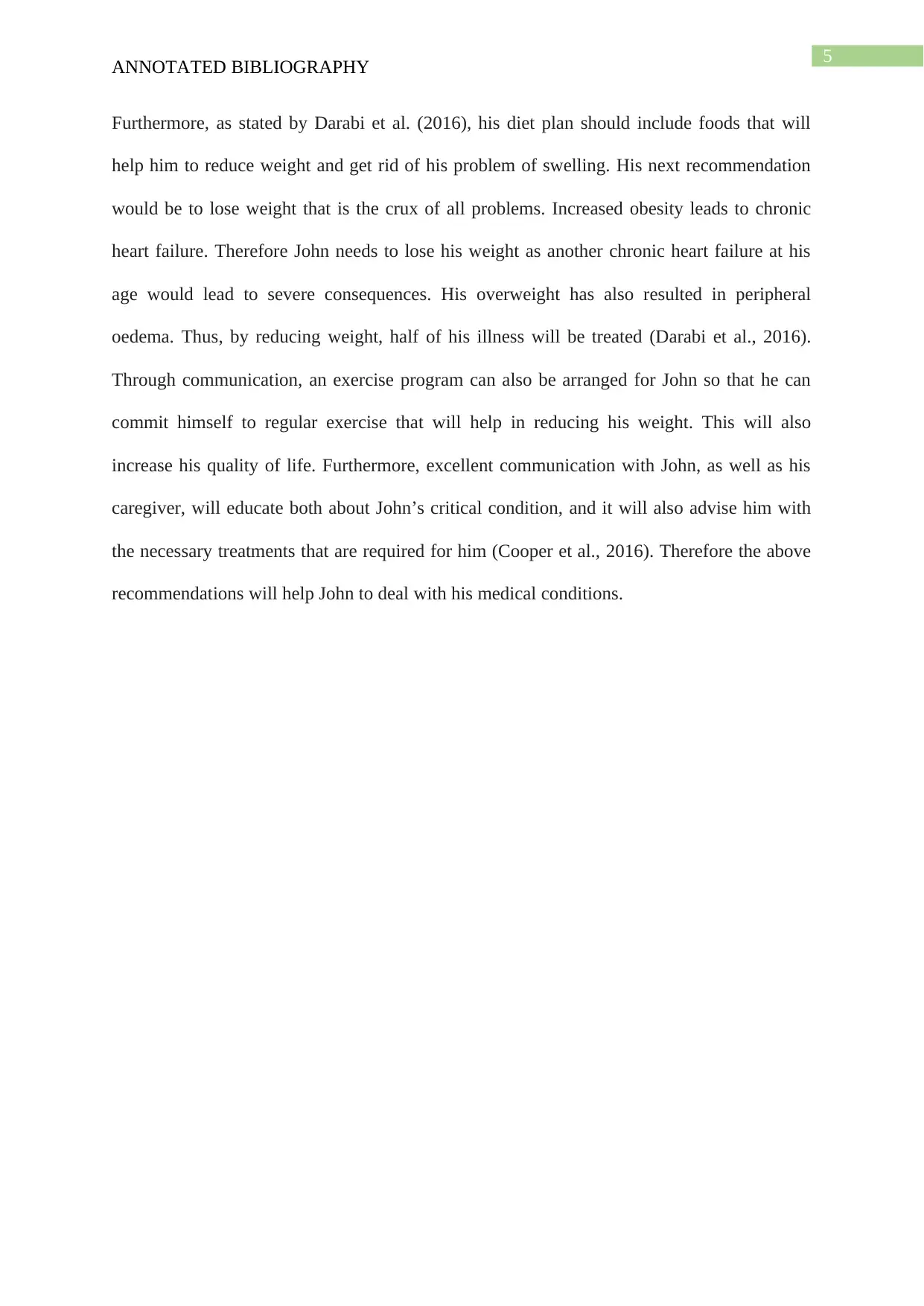
5
ANNOTATED BIBLIOGRAPHY
Furthermore, as stated by Darabi et al. (2016), his diet plan should include foods that will
help him to reduce weight and get rid of his problem of swelling. His next recommendation
would be to lose weight that is the crux of all problems. Increased obesity leads to chronic
heart failure. Therefore John needs to lose his weight as another chronic heart failure at his
age would lead to severe consequences. His overweight has also resulted in peripheral
oedema. Thus, by reducing weight, half of his illness will be treated (Darabi et al., 2016).
Through communication, an exercise program can also be arranged for John so that he can
commit himself to regular exercise that will help in reducing his weight. This will also
increase his quality of life. Furthermore, excellent communication with John, as well as his
caregiver, will educate both about John’s critical condition, and it will also advise him with
the necessary treatments that are required for him (Cooper et al., 2016). Therefore the above
recommendations will help John to deal with his medical conditions.
ANNOTATED BIBLIOGRAPHY
Furthermore, as stated by Darabi et al. (2016), his diet plan should include foods that will
help him to reduce weight and get rid of his problem of swelling. His next recommendation
would be to lose weight that is the crux of all problems. Increased obesity leads to chronic
heart failure. Therefore John needs to lose his weight as another chronic heart failure at his
age would lead to severe consequences. His overweight has also resulted in peripheral
oedema. Thus, by reducing weight, half of his illness will be treated (Darabi et al., 2016).
Through communication, an exercise program can also be arranged for John so that he can
commit himself to regular exercise that will help in reducing his weight. This will also
increase his quality of life. Furthermore, excellent communication with John, as well as his
caregiver, will educate both about John’s critical condition, and it will also advise him with
the necessary treatments that are required for him (Cooper et al., 2016). Therefore the above
recommendations will help John to deal with his medical conditions.
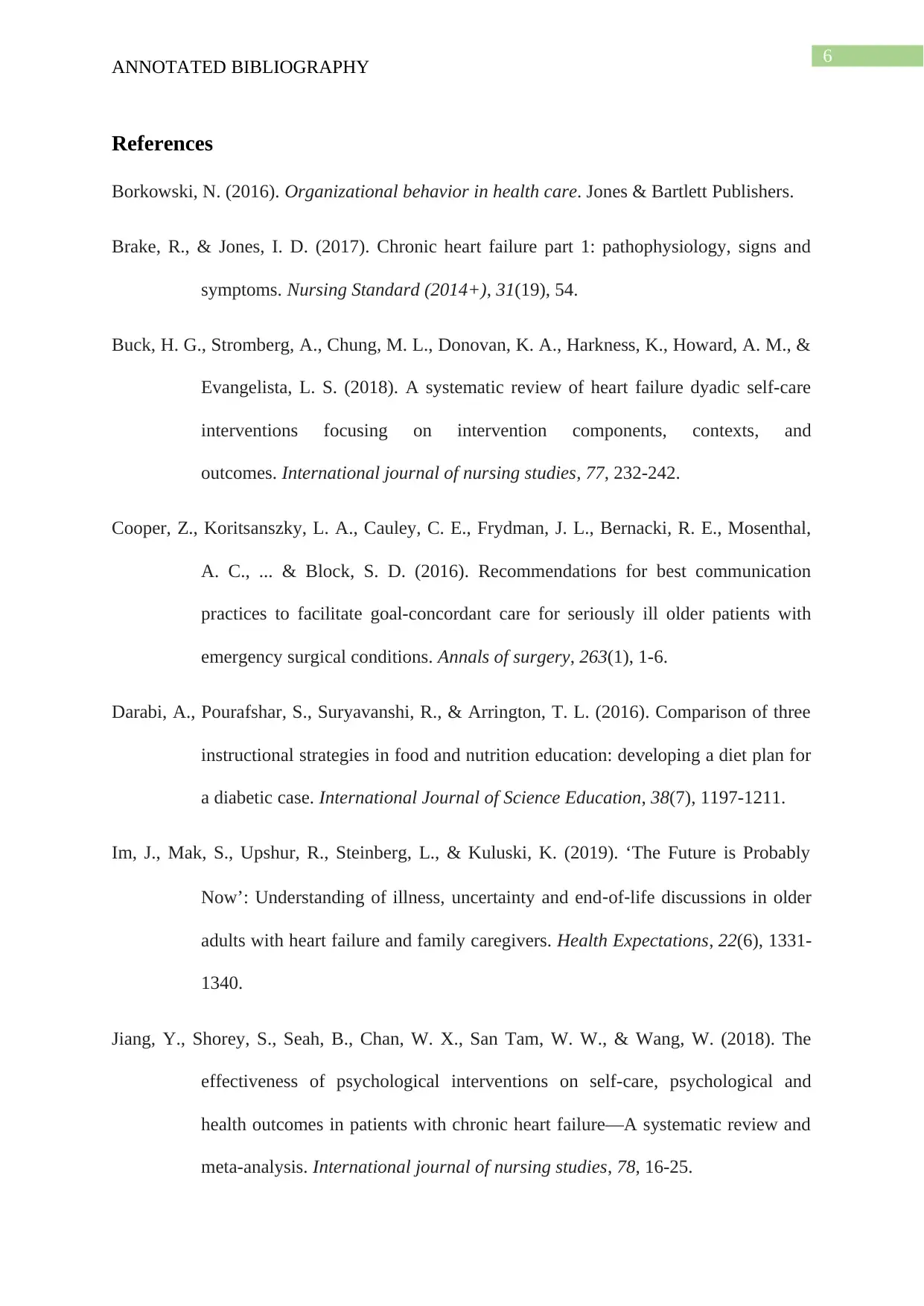
6
ANNOTATED BIBLIOGRAPHY
References
Borkowski, N. (2016). Organizational behavior in health care. Jones & Bartlett Publishers.
Brake, R., & Jones, I. D. (2017). Chronic heart failure part 1: pathophysiology, signs and
symptoms. Nursing Standard (2014+), 31(19), 54.
Buck, H. G., Stromberg, A., Chung, M. L., Donovan, K. A., Harkness, K., Howard, A. M., &
Evangelista, L. S. (2018). A systematic review of heart failure dyadic self-care
interventions focusing on intervention components, contexts, and
outcomes. International journal of nursing studies, 77, 232-242.
Cooper, Z., Koritsanszky, L. A., Cauley, C. E., Frydman, J. L., Bernacki, R. E., Mosenthal,
A. C., ... & Block, S. D. (2016). Recommendations for best communication
practices to facilitate goal-concordant care for seriously ill older patients with
emergency surgical conditions. Annals of surgery, 263(1), 1-6.
Darabi, A., Pourafshar, S., Suryavanshi, R., & Arrington, T. L. (2016). Comparison of three
instructional strategies in food and nutrition education: developing a diet plan for
a diabetic case. International Journal of Science Education, 38(7), 1197-1211.
Im, J., Mak, S., Upshur, R., Steinberg, L., & Kuluski, K. (2019). ‘The Future is Probably
Now’: Understanding of illness, uncertainty and end‐of‐life discussions in older
adults with heart failure and family caregivers. Health Expectations, 22(6), 1331-
1340.
Jiang, Y., Shorey, S., Seah, B., Chan, W. X., San Tam, W. W., & Wang, W. (2018). The
effectiveness of psychological interventions on self-care, psychological and
health outcomes in patients with chronic heart failure—A systematic review and
meta-analysis. International journal of nursing studies, 78, 16-25.
ANNOTATED BIBLIOGRAPHY
References
Borkowski, N. (2016). Organizational behavior in health care. Jones & Bartlett Publishers.
Brake, R., & Jones, I. D. (2017). Chronic heart failure part 1: pathophysiology, signs and
symptoms. Nursing Standard (2014+), 31(19), 54.
Buck, H. G., Stromberg, A., Chung, M. L., Donovan, K. A., Harkness, K., Howard, A. M., &
Evangelista, L. S. (2018). A systematic review of heart failure dyadic self-care
interventions focusing on intervention components, contexts, and
outcomes. International journal of nursing studies, 77, 232-242.
Cooper, Z., Koritsanszky, L. A., Cauley, C. E., Frydman, J. L., Bernacki, R. E., Mosenthal,
A. C., ... & Block, S. D. (2016). Recommendations for best communication
practices to facilitate goal-concordant care for seriously ill older patients with
emergency surgical conditions. Annals of surgery, 263(1), 1-6.
Darabi, A., Pourafshar, S., Suryavanshi, R., & Arrington, T. L. (2016). Comparison of three
instructional strategies in food and nutrition education: developing a diet plan for
a diabetic case. International Journal of Science Education, 38(7), 1197-1211.
Im, J., Mak, S., Upshur, R., Steinberg, L., & Kuluski, K. (2019). ‘The Future is Probably
Now’: Understanding of illness, uncertainty and end‐of‐life discussions in older
adults with heart failure and family caregivers. Health Expectations, 22(6), 1331-
1340.
Jiang, Y., Shorey, S., Seah, B., Chan, W. X., San Tam, W. W., & Wang, W. (2018). The
effectiveness of psychological interventions on self-care, psychological and
health outcomes in patients with chronic heart failure—A systematic review and
meta-analysis. International journal of nursing studies, 78, 16-25.
Paraphrase This Document
Need a fresh take? Get an instant paraphrase of this document with our AI Paraphraser
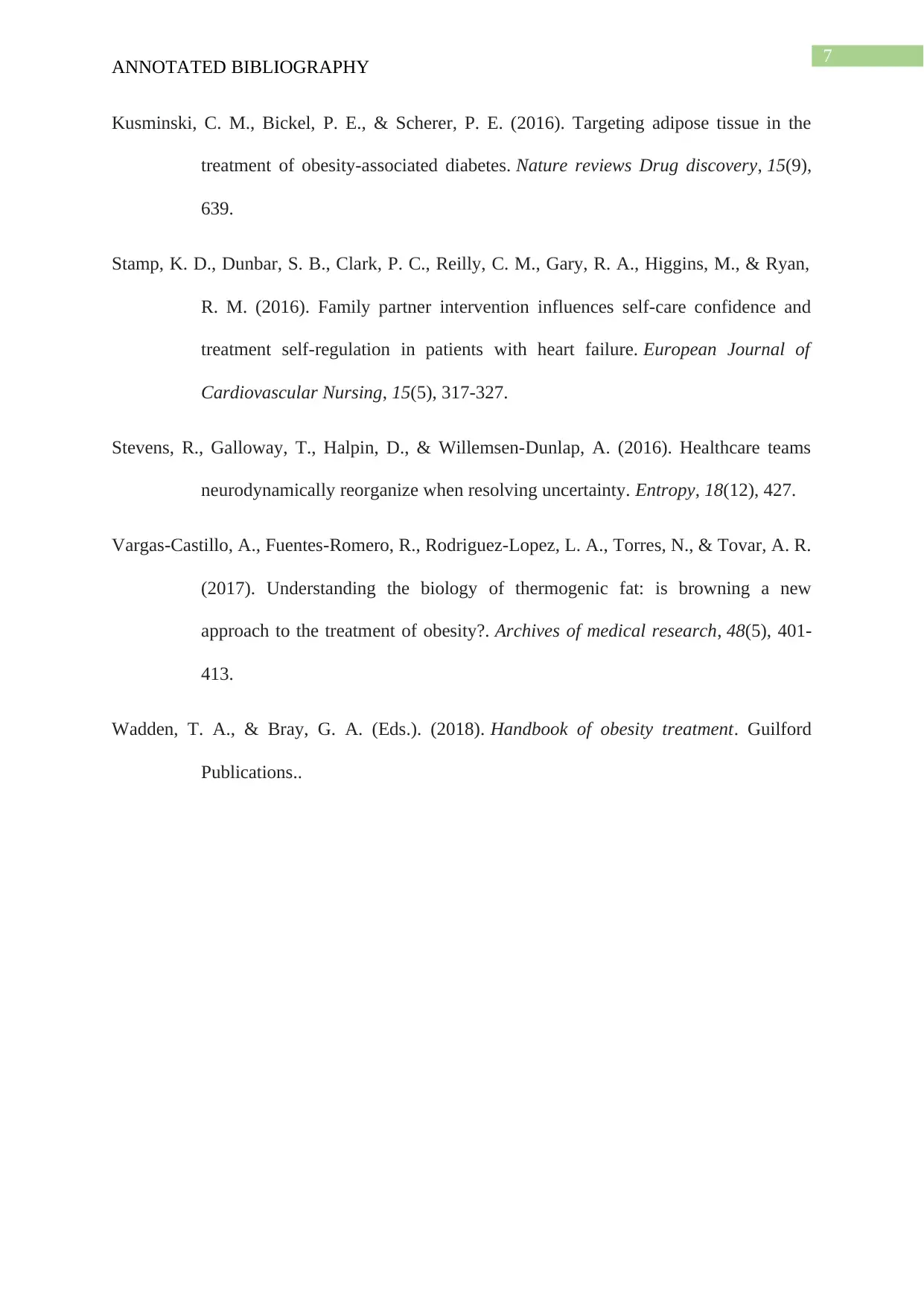
7
ANNOTATED BIBLIOGRAPHY
Kusminski, C. M., Bickel, P. E., & Scherer, P. E. (2016). Targeting adipose tissue in the
treatment of obesity-associated diabetes. Nature reviews Drug discovery, 15(9),
639.
Stamp, K. D., Dunbar, S. B., Clark, P. C., Reilly, C. M., Gary, R. A., Higgins, M., & Ryan,
R. M. (2016). Family partner intervention influences self-care confidence and
treatment self-regulation in patients with heart failure. European Journal of
Cardiovascular Nursing, 15(5), 317-327.
Stevens, R., Galloway, T., Halpin, D., & Willemsen-Dunlap, A. (2016). Healthcare teams
neurodynamically reorganize when resolving uncertainty. Entropy, 18(12), 427.
Vargas-Castillo, A., Fuentes-Romero, R., Rodriguez-Lopez, L. A., Torres, N., & Tovar, A. R.
(2017). Understanding the biology of thermogenic fat: is browning a new
approach to the treatment of obesity?. Archives of medical research, 48(5), 401-
413.
Wadden, T. A., & Bray, G. A. (Eds.). (2018). Handbook of obesity treatment. Guilford
Publications..
ANNOTATED BIBLIOGRAPHY
Kusminski, C. M., Bickel, P. E., & Scherer, P. E. (2016). Targeting adipose tissue in the
treatment of obesity-associated diabetes. Nature reviews Drug discovery, 15(9),
639.
Stamp, K. D., Dunbar, S. B., Clark, P. C., Reilly, C. M., Gary, R. A., Higgins, M., & Ryan,
R. M. (2016). Family partner intervention influences self-care confidence and
treatment self-regulation in patients with heart failure. European Journal of
Cardiovascular Nursing, 15(5), 317-327.
Stevens, R., Galloway, T., Halpin, D., & Willemsen-Dunlap, A. (2016). Healthcare teams
neurodynamically reorganize when resolving uncertainty. Entropy, 18(12), 427.
Vargas-Castillo, A., Fuentes-Romero, R., Rodriguez-Lopez, L. A., Torres, N., & Tovar, A. R.
(2017). Understanding the biology of thermogenic fat: is browning a new
approach to the treatment of obesity?. Archives of medical research, 48(5), 401-
413.
Wadden, T. A., & Bray, G. A. (Eds.). (2018). Handbook of obesity treatment. Guilford
Publications..
1 out of 8
Related Documents
Your All-in-One AI-Powered Toolkit for Academic Success.
+13062052269
info@desklib.com
Available 24*7 on WhatsApp / Email
![[object Object]](/_next/static/media/star-bottom.7253800d.svg)
Unlock your academic potential
© 2024 | Zucol Services PVT LTD | All rights reserved.





